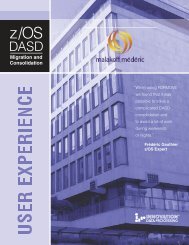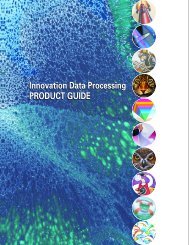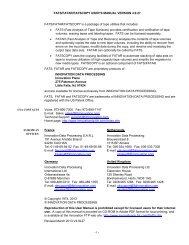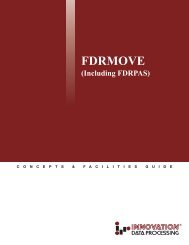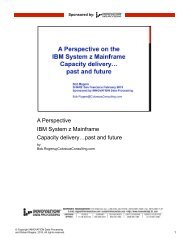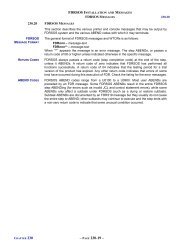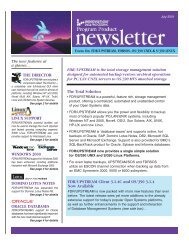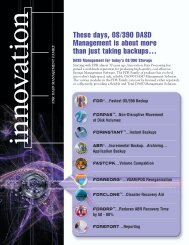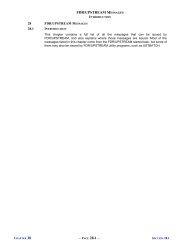FDR V54L78 - Innovation Data Processing
FDR V54L78 - Innovation Data Processing
FDR V54L78 - Innovation Data Processing
You also want an ePaper? Increase the reach of your titles
YUMPU automatically turns print PDFs into web optimized ePapers that Google loves.
MESSAGES AND CODES<br />
MESSAGES FROM <strong>FDR</strong>, DSF, AND ABR (<strong>FDR</strong>NNN) 100.3<br />
Action:<br />
X – A DSF absolute track restore was requested (SELECT FROM/TO) and<br />
cylinder or track numbers were specified that are invalid for the type of disk<br />
that was backed up.<br />
Y – OLDBACKUP was specified. The data set does not contain as many levels<br />
of OLDBACKUP information as requested by the OLDB=nn operand or the<br />
specified backup is no longer in the ABR catalog.<br />
Z – An ABR data set restore was requested and a TAPEx DD statement was<br />
provided, but the backup containing this data set occupies more than 5 tape<br />
volumes. To restore this data set, remove the TAPEx DD and specify the<br />
DYNTAPE option. This code also occurs if you use the TAPED=x operand on<br />
an archive restore (TYPE=ARC) or application restore (TYPE=APPL).<br />
Take appropriate action for the problem described by the message.<br />
<strong>FDR</strong>323 DDNAME=DISKdddd DOES NOT SPECIFY A DISK<br />
Reason: DD statements whose DDnames start with DISK must point to a disk device.<br />
Action: Correct and resubmit job.<br />
<strong>FDR</strong>324 DDNAME=dddddddd IS MISSING OR IN ERROR REASON=x<br />
Reason: A failure has occurred for DDname specified in the message. In the reason text below,<br />
“Control File” refers to the Archive Control File for Archive Backups, and to the<br />
Application Control File for Application Backups. The reason code “x” may be:<br />
1 – SYSIN DD statement missing.<br />
2 – I/O error on SYSIN data set or remote queue data set.<br />
3 – ARCHIVE DD statement missing and DYNARC was not specified.<br />
4 – Control File block size is zero. The file may have been allocated but never<br />
initialized. If so, use <strong>FDR</strong>ARCH to initialize it.<br />
5 – I/O error on Control File.<br />
6 – The date of the last Archive or Application backup, as recorded in the<br />
Control File, is higher than the current system date; this might occur if you<br />
did backups while you had the system date set ahead for YEAR2000<br />
testing. To override the ABR date check, specify PROT=NONE on the<br />
DUMP statement of next Archive or Application job using that Control<br />
File only. The Control File will be out of date sequence.<br />
7 – A block of the Control File did not contain ABR identifiers. The Control File<br />
may have been overwritten by another program. You may be able to restore<br />
a backup of the most recent Control File. Please call INNOVATION DATA<br />
PROCESSING for assistance.<br />
8 – The Control File is full. You can reorganize or expand it with <strong>FDR</strong>ARCH. If<br />
you are using the option of Application Backup to create the Control File,<br />
increase the space allocated.<br />
9 – The number of TAPEx DD statements exceeded 9.<br />
A – No TAPEx DD statements were specifying tape or disk backup were found.<br />
ABR ignores DD DUMMY statements<br />
B – The number of DISKxxxx DD statements plus any volumes selected by<br />
ONLINE, ONLVOL, and MOUNT was greater than the value specified in the<br />
MAXDD operand (default of 256).<br />
D – A SYSPRINx DD statement was missing. ABR requires a SYSPRINx DD<br />
statement for each TAPEx DD statement.<br />
E – A DISKx DDname was used more than once in the JCL for this step.<br />
F – A <strong>FDR</strong> or <strong>FDR</strong>DSF backup specified DISP=MOD on the TAPEx DD card. Also<br />
occurs if the TAPEx DD refers to a subsystem data set (such as ExHPDM) via<br />
the SUBSYS= JCL parameter, and the RTC=YES operand was also specified<br />
on the DUMP statement; these are not compatible. The disk volume associated<br />
with this tape is not processed.<br />
I – OPEN failed for the backup file. Check the job log for IBM error messages.<br />
CHAPTER 100 – PAGE 100-67 –




